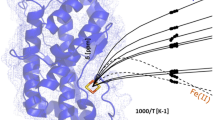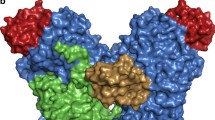Abstract
Diiron-oxo proteins currently represent one of the most rapidly developing areas of bioinorganic chemistry. All of these proteins contain a four-helix bundle protein fold surrounding a (μ-carboxylato)diiron core, and most, if not all, of the diiron(II) sites appear to react with O2 as part of their functional processes. Despite these common characteristics, an emerging functional diversity is one of the most striking aspects of this class of proteins. X-ray crystal structures of diiron(II) sites are now available for four of these proteins: hemerythrin (Hr), the hydroxylase protein of methane monooxygenase (MMOH), the R2 protein of Escherichia coli ribonucleotide reductase (RNR-R2), and a plant acyl-carrier protein Δ9-desaturase. The structure of the diiron(II) site in Hr, the sole O2 carrier in the group, is clearly distinct from the other three, whose function is oxygen activation. The Hr diiron site is more histidine rich, and the oxygen-activating diiron sites contain a pair of (D/E)X30–37EX2H ligand sequence motifs, which is clearly not found in Hr. The Hr diiron site apparently permits only terminal O2 coordination to a single iron, whereas the oxygen-activating diiron(II) centers present open or labile coordination sites on both irons of the center, and show a much greater coordinative flexibility upon oxidation to the diiron(III) state. Intermediates at the formal FeIIIFeIII and FeIVFeIV oxidation levels for MMOH and formal FeIIIFeIV oxidation level for RNR-R2 have been identified during reactions of the diiron(II) sites with O2. An [Fe2(μ-O)2]4+, 3+ "diamond core" structure has been proposed for the latter two oxidation levels. The intermediate at the FeIIIFeIV oxidation level in RNR-R2 is kinetically competent to generate a stable, functionally essential tyrosyl radical. The FeIVFeIV oxidation level is presumed to effect hydroxylation of hydrocarbons in MMOH, but the mechanism of this hydroxylation, particularly the involvement of discrete radicals, is currently controversial. The biological function of diiron sites in three members of this class, rubrerythrin, ferritin and bacterioferritin, remains enigmatic.
Similar content being viewed by others
Author information
Authors and Affiliations
Additional information
Received: 31 July 1996 / Accepted: 4 October 1996
Rights and permissions
About this article
Cite this article
Kurtz Jr., D. Structural similarity and functional diversity in diiron-oxo proteins. JBIC 2, 159–167 (1997). https://doi.org/10.1007/s007750050120
Issue Date:
DOI: https://doi.org/10.1007/s007750050120




